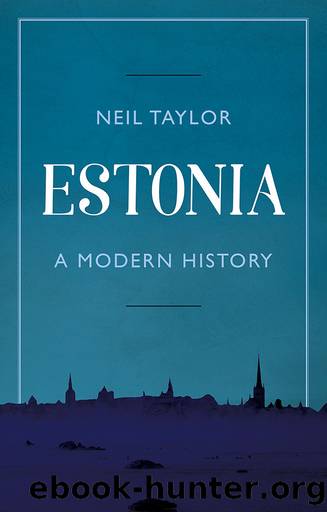Estonia by Neil Taylor

Author:Neil Taylor [Taylor, Neil]
Language: eng
Format: epub
ISBN: 9781787381667
Publisher: Hurst
Published: 2018-09-15T00:00:00+00:00
Changes after Stalinâs death
Stalin died on 5 March 1953; Meri celebrated the day by proposing to his first wife and suggesting that they would âremember this happy day foreverâ.âWe knew we were not allowed to laugh, but we certainly did not shed any tears when Stalin diedâ, was probably a more common reaction.16
Stalin perhaps died because nobody dared to treat him; former General Laidoner died a week later, on 13 March, because nobody cared to treat him. His death was ignored in the Soviet Estonian press, as would be that of Päts three years later. Both had been deported in 1940. It remains a mystery why these two were kept alive when most of their colleagues were murdered. Perhaps Stalin wanted them as a bargaining chip had the Western powers negotiated more strongly at Yalta and Potsdam. Laidonerâs wife Maria would live for a further twenty-five years, until 1978. She had been kept in solitary confinement after the war, being allowed just one visit to her husband in 1952. After he died, she was allowed to live in Melenki, near Vladimir, where she ran a music school. In the 1960s, Maria was allowed to return to Estonia, but not to Tallinn, except for day trips. She settled in Haapsalu, and her house there now has a plaque in Polish and in Estonian, as Polish was her original nationality. Being watched all the time, Maria had few visitors, since they would have been concerned at the consequences of visiting a âbourgeois enemyâ. However, she was able to benefit from the shift in atmosphere that came with Stalinâs death in 1953 and then the liberalising policy changes that followed Khrushchevâs âSecret Speechâ in 1956. For other exiled Estonians who survived the changes that came with Stalinâs death, life slowly became easier too, with releases from the gulags and more opportunities for returning to Estonia, or at least to near its borders. Otto Tief, for instance, leader of the four-day government in September 1944, was released from Siberia in 1956 and briefly allowed to return to Estonia, before being sent to Ukraine for the next ten years. He would then be sent to Ainaži in Latvia, a town on the coast on the Estonian border. Tief could finally return to Estonia in 1976, a few months before he died. Thousands of others suffered similarly haphazard fates at the hands of a Soviet regime with, as in so many other aspects of its rule in Estonia, no coherent policy to explain it. Although Estonians continued to be sent to gulags until the 1980s, this policy at least became restricted from the 1950s to individual courageous dissidents. The mass deportations of 1941 and 1949 were never repeated.
This ambivalent policy could frequently also be seen in publishing, even though only one national publisher was allowed, Eesti Riiklik Kirjastus. By 1950, any pre-war members of staff who remained at the publisher had been dismissed as bourgeois nationalists. The number of titles available in the Estonian language dropped from the pre-war number of 1,600 to 500.
Download
This site does not store any files on its server. We only index and link to content provided by other sites. Please contact the content providers to delete copyright contents if any and email us, we'll remove relevant links or contents immediately.
Room 212 by Kate Stewart(5040)
The Crown by Robert Lacey(4726)
Endurance: Shackleton's Incredible Voyage by Alfred Lansing(4679)
The Iron Duke by The Iron Duke(4293)
The Rape of Nanking by Iris Chang(4139)
Joan of Arc by Mary Gordon(4016)
Killing England by Bill O'Reilly(3953)
Say Nothing by Patrick Radden Keefe(3903)
I'll Give You the Sun by Jandy Nelson(3359)
Shadow of Night by Deborah Harkness(3306)
Hitler's Monsters by Eric Kurlander(3269)
Mary, Queen of Scots, and the Murder of Lord Darnley by Alison Weir(3152)
Blood and Sand by Alex Von Tunzelmann(3140)
Darkest Hour by Anthony McCarten(3072)
Eleanor & Park by Rainbow Rowell(3063)
Margaret Thatcher: The Autobiography by Thatcher Margaret(3029)
Red Famine: Stalin's War on Ukraine by Anne Applebaum(2873)
Book of Life by Deborah Harkness(2869)
The One Memory of Flora Banks by Emily Barr(2803)
